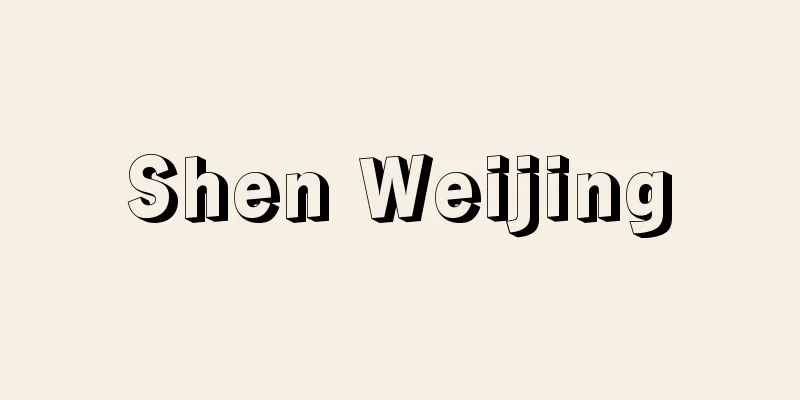Washi paper - Washi

|
This refers to handmade paper made in Japan. It is also called "wagami" as opposed to Western paper. Originally, paper was made by dispersing plant fibers in water, filtering the water, and intertwining them into a thin, flat sheet, which was used for writing, printing, and wrapping things. Its raw materials and manufacturing methods have changed over time and over the region, but the principles of papermaking have remained the same. While Western paper is mass-produced by machine using wood pulp, washi paper is characterized by being made entirely by hand using plant bast fibers. Handmade papermaking is also practiced in other countries, but most of it is made using linters and hemp rags as the main raw materials, using the so-called "tamemi-suki" method. In contrast, washi paper is made from bast fibers of mulberry, mitsumata, gampi, and other plants, and is made by mixing a vegetable mucilage called "neri" into the paper making liquid to thoroughly and uniformly intertwine these long fibers. This method, which was uniquely invented and popularized by dexterous Japanese people, requires skilled dexterity. This allows a large amount of very thin paper to be made with a small amount of material, and the paper has a uniform and beautiful texture and is very strong. However, because it is porous, it is suitable for writing with ink, but is generally not suitable for writing with ink or printing. This is in contrast to Western paper, which has a dense structure with short and small fibers, and is treated with sizing (a process that prevents bleeding with water-resistant substances such as rosin and synthetic resin). However, ganpishi paper is dense and hard, so it is possible to write on it with a pen. In addition to being used for writing, washi paper has many other uses in everyday life in Japan. Through a wide variety of processing, it was produced all over the country until recently as a necessity that naturally combines practicality and aesthetic effects, and has made a unique contribution to Japanese culture. The excellent properties of washi paper have long been noted around the world, but at one time it became economically difficult to produce due to the popularity of Western paper. However, in recent years it has been rediscovered as a material for crafts and plastic arts, and is being protected and nurtured as a traditional industry. [Machida Masayuki] In 2009, "Sekishu Banshi" (Iwami Banshi) from Hamada City, Shimane Prefecture was registered alone as an Intangible Cultural Heritage by UNESCO (United Nations Educational, Scientific and Cultural Organization), and in 2014, "Washi - Japanese Handmade Paper Techniques" was once again registered as an Intangible Cultural Heritage, adding "Honminoshi" from Mino City, Gifu Prefecture, and "Hosokawashi" from Ogawa Town and Higashichichibu Village, Saitama Prefecture to Sekishu Banshi. [Editorial Department] historyThe first article on papermaking in Japan can be found in the 22nd volume of the "Nihon Shoki," in the 18th year of the reign of Empress Suiko (610), which says, "In the third month of spring, two monks, Doncho and Hotei, came to Japan from Goryeo. Doncho was well versed in the Chinese classics, was an expert in making paints, paper, and ink, and was the first person in Japan to use water power to operate a mortar." The article does not say that Doncho was the first to make paper, so it can be interpreted as a formal introduction of the technology. In fact, paper itself had already been brought to Japan from China via the Korean Peninsula during the Kofun period as a diplomatic document or a personal souvenir, so it is believed that papermaking was already taking place somewhere in Japan by immigrants. At that time, paper was a valuable commodity, and the paper brought from China was called "tōshi" and was a rare imported product. It was only after the national system was established and the Ritsuryo system was put into place that the demand for paper increased in Japan and domestic production was encouraged. Family registries were created in the mid-7th century for tax purposes, and Buddhism was spread to stabilize people's minds. The demand for paper as a medium for transmitting written information increased dramatically, and papermaking saw rapid development in both quantity and quality. During the Nara period, the enormous amount of paper required for copying sutras was produced at the Zushoryo Papermaking Plant, and according to historical records, 21 copies of the Issaikyo were copied in just the 62 years between 710 and 772 (Wado 3 to Hoki 3), with 3,500 copies of each, and 150 sheets of paper per roll, for a total of approximately 11,025,000 sheets of paper. Most imported karakami was made from hemp paper, but domestically produced paper was made from paper made from mulberry paper, hishi paper, and many other plant fibers. In the late Nara period, a revolutionary technique called nagashisuki was developed as a rational method for making large quantities of strong paper by effectively using these raw materials, and came to characterize washi paper. This was the result of research into the viscous nature of the fibers of the gampi (Thymelaeaceae), a species endemic to Japan, which was discovered to be a unique characteristic of the paper-making process of Hi-shi. Paper was also made in provincial offices far from the capital, and used for family registries, accounting books, religious purposes, and was also donated to the central government along with raw materials. Detailed information about paper from the Nara period can be found in the Shosoin documents, and there are over 230 names for paper, depending on the raw materials, uses, and processing methods such as dyeing, and many of the original papers still remain. The Hyakuman To Darani (One Million Pagodas Dharani), said to be the world's oldest surviving printed matter, completed in 770 (the 1st year of the Hoki era), is also a monument that demonstrates the paper-making capabilities of the time. Shortly after the capital was moved to Heian-kyo, during the Daido era (806-810) of Emperor Saga, Kamiyain, an auxiliary library for papermaking and research, was expanded and relocated to the banks of the Kamiya River, and played a leading role in papermaking throughout the country. The organization and work of Kamiyain are shown in the "Library Style" section of the Engishiki, and provide a glimpse into papermaking at the time. The elegant paper made in this favorable environment was loved by aristocrats under the name "Kamiyagami," and was also exported back to China as it was considered to be of higher quality than imported Karakami. Words praising Kamiyagami can often be found in works of court literature by women, such as The Tale of Genji and The Pillow Book. However, towards the end of the Heian period, as if reflecting the decline in the prestige of the regent government and the rise of local influential people, the reputation of Kamiya-gami and Kamiya-in declined, and instead, beautiful local paper began to flow into the capital. The forerunner of this was "Mutsu paper" from the Tohoku region, and Murasaki Shikibu also compared its elegance to Kamiya-gami. The quality of this paper suited the tastes of the people of the Imperial Court, and men called it Danshi in the Chinese style, and women called it Mayumi-gami, and its usage is recorded in literary works and diaries of the time. Papermaking became even more popular among the various industries that became wealthy through income from local manors, and local paper showed such momentum that it overwhelmed Kamiya-gami from the center. Then, around the time that Emperor Shirakawa began his cloistered rule, kamiyagami fell into decline and came to mean recycled, respun paper, or "shukushi." From the Kamakura period to the Muromachi period, samurai replaced nobles in power, and mulberry paper, a type of sandalwood paper, was made not only in Mutsu Province, but also in Sanuki Province (Kagawa), Echizen Province (Fukui), Bitchu Province (Okayama), and other places. Just as nobles used it as pocket paper, samurai used it in the hikiawase (the part of the right side of the torso where the front and back are tightened and joined together), which is why it came to be called hikiawase. Sugihara paper from Harima Province (Hyogo) and hosho paper from Echizen Province also began to appear around this time. On the other hand, Hishi paper is divided into two types: Ganpishi, also known as Torinoko paper, and Mitsumatagami, which is not this color (light yellow), and developed in the Goka Villages of Echizen and the Izu area of Suruga Province (Shizuoka) and spread throughout the country. Ganpishi was popular with foreign missionaries because it is smooth and can be written on with a pen, and many of the names of papers belonging to this category were later collected in the "Nippo Jisho" (Japanese-Portuguese Dictionary), published in Nagasaki in 1603 (Keicho 8). During the Muromachi period, the Shoin-zukuri architectural style became popular, and with it the demand for paper, used for sliding doors and light-screen doors, increased, and the production of paper for umbrellas also increased throughout the country, including Mino Province (Gifu) and Tosa Province (Kochi). In addition, Nara paper and Yoshino paper from Yamato Province (Nara) came to be widely used as tissue paper, and in the Edo period, paper came to have a variety of uses as a necessity in the daily lives of ordinary people. During the Edo period, paper trade flourished thanks to the efforts of economically powerful townspeople, and feudal domains competed to encourage papermaking as a source of revenue. When movable type printing technology was imported, "Nara ehon" and "Saga hon" became popular, and the rise of Edo literature increased the demand for paper as a form of book production, while ukiyo-e woodblock prints, which delighted the eyes of the common people, led to the development of paper processing technology. Some feudal domains also established monopolies for the versatile writing paper, shoji paper, and tissue paper, and paper trading flourished in the Osaka market along with Edo. According to records from 1736 (Genbun 1), paper was the third largest item in terms of sales in the Osaka market, after rice and lumber. In addition to the feudal lords of each domain, large temples and shrines also established storehouses in Osaka to supply their products, but this officially handled paper was called "Okuragami" (storehouse paper) and was differentiated from private storehouse paper or side items, and its quality was controlled. However, the total volume handled was said to be over 170,000 rounds per year for side items, while the storehouse paper averaged 130,000 rounds per year (1 round is 12,000 sheets of washi paper). This was truly the heyday of washi paper. Since the Meiji era, with the influx of Western paper, Japanese paper has been in a steady decline, losing its practical use as lifestyles changed, and now it is only made as a traditional craft. However, experts around the world have lavished praise on washi paper for its exceptional durability, strength, and elegance, and recently in Japan there has been a growing movement to preserve washi paper, which is deeply linked to Japanese culture. [Machida Masayuki] Manufacturing methodOf the main raw materials for washi, wild species of gampi are difficult to cultivate, and the bark is harvested in summer and stripped raw. Cultivated species of paper mulberry and mitsumata are mainly cut in autumn, cut to the same length, and stored in bundles. They are then steamed in a bucket over an iron flat pot, and once the bundles have steamed sufficiently, they are placed on a mat, poured with water, and the bark is quickly peeled off. These rough barks are called kurokawa, and are dried and stored. To remove the black epidermis from the kurokawa, it is further soaked in water to soften it and then scraped off with a small knife, or the black bark is immersed in a shallow stream and stomped on with feet, a process known as kozofumi, to wash off the epidermis. The white bark obtained in this way is then dried, and the bundles of bast fibers become the raw material for washi. To make paper, the required amount of shirokawa is taken, soaked in water for about half a day, and then put into a kettle and cooked (also called shajuku) in an alkaline solution. In the past, lye from wood or straw was used as the alkaline solution, but now lime, soda ash, and caustic soda are also used. This dissolves the soluble impurities in the fibers, but strong chemicals can easily corrode the cellulose itself, so great care must be taken. Usually, after about an hour, the shirokawa becomes soft enough to be picked up with the fingers, so the heating is stopped and it is left to cool, then it is washed in running water in a process known as "river bleaching". At this time, the shirokawa is naturally bleached, but in some regions it is buried in snow for a long time ("yuki-arashi"), left on the grass ("tenpi-arashi"), or bleaching powder or other bleaching agents are used. After this, small amounts of the fibers are placed into running water or a bucket, and any remaining rough skin, tough veins, and dust are painstakingly removed by hand, a process known as "dust removal." Next, the fully refined fibers are rolled into large chunks the size of a melon, a process known as "kozo shibori." These chunks are placed on a flat wooden or stone platform and beaten with a hard wooden stick or mallet. This process is called "kamiuchi," "kozouchi," or "teuchi," and it tears the bast fibers into small pieces (fibrillation), increasing their surface area, and hydrating them to make them flexible and plastic. The sound of this well-tuned beating is called kamikinuta, and can be heard far and wide. Sometimes the paper is beaten with a beater or crushed in a mortar, but using mechanical force often cuts the fibers, and only the traditional hand-made method can produce the beauty and strength that is inherent to washi. After all of this processing has been completed, the fibers (paper stock) are placed in a tank (a papermaking boat), water is added, the paper is stirred well, and the paper is then scooped up on a mesh or a sieve. Outside of Japan, the papermaking method is known as tame-suki, in which the paper stock fibers are gently rocked on a mesh to filter out the water, and the layer of intertwined fibers is transferred to the "shito," where the mesh is gently removed and a cloth is placed over the wet paper. A "shito" is a pile of wet paper and cloth like this. However, the unique nagashi-suki method of Japanese paper requires a plant-derived mucilage called neri. Traditionally, the mucilage extracted from the roots of the Tororo-aoi (Aois aurea) or the inner bark of the Nori-utsugi (Glue Tree) is crushed and mixed with water to create a white milky liquid. The amount of neri added is usually determined by the feel of an experienced hand, but it is mixed well with the paper stock liquid to create a white milky liquid. In papermaking, the liquid is pumped up on a sieve fitted with a beam and quickly spread over the entire surface of the sieve. This first pumping is an important step in forming the surface of the paper, and is called "ubumizu," "kinsui," or "kazushi" depending on the region. It creates a relatively coarse fiber layer that allows the water to filter quickly. The liquid is then pumped up again, this time a little deeper, and the sieve is rocked back and forth, allowing the fibers to orient themselves as the liquid flows, and to become tightly intertwined. This operation is called "choshi" and is repeated depending on the desired thickness of the paper. As the mesh of the screen gradually closes, the water leakage slows down, and the paper layer structure is evened out. Also, lumps caused by irregular tangles of fibers and debris that has been mixed in noticeably become floating, so these are finally thrown back into the tank from the front of the girder with force together with the excess liquid remaining on the screen. This is called "sutemizu" (scraping water), and is one of the unique techniques that can only be done with the Nagashisuki method. The screen with the paper layer on it is removed from the girder, turned face down on the paper bed and gently peeled off only the screen, then placed back on the girder and the same papermaking operation as before is repeated. The wet paper on the paper bed is stacked on top of it. This is another unique feature of the Nagashisuki method, and there is no need to stack each wet paper with a cloth between them as in the Tamesuki method. The paper bed is left as it is overnight, and then the water is drained by placing weights on top or using a balance, and at the appropriate time, the sheets are peeled off one by one and pasted on a drying board and left in the sun to dry naturally. On a sunny day, it will dry in about an hour, so the sheets are peeled off from the board, sorted, cut if necessary, and wrapped to make the final product. [Machida Masayuki] The effect of NeriNeri (also called "nebeshi", "nori", "tamo" or "sana" in some regions) is what makes the "nagashi" method of washi papermaking possible. The mucilage of Abelmoschus truncatula, which is most commonly used for this, is a long-chain complex polysaccharide made up of rhamnose and galacturonic acid, and the mucilage of Deutzia pratensis is a similar polysaccharide. These polymers have a molecular structure similar to that of hemicellulose, which is abundant in bast fibers such as gampi, and both are water-soluble polymers known as polyuronides. When polyuronides dissolve in water, they become a colloidal solution, and the long molecules spread out in the water and become entangled like a net, exhibiting demulcent and spinnability. The cellulose in the paper stock fiber has already been fibrillated by beating and swelled with water, with its surface covered with hydrated cellulose and hemicellulose molecules like down. When these fibers are dispersed in the mashing liquid, the long polyuronide molecules cling to the downy hairs, and the entire fiber is enveloped in an even larger hydration layer, preventing the long fibers from agglomerating through direct contact with each other and promoting uniform dispersion. When the fibers are pumped up onto a sieve and shaken, the viscosity and spinnability of the liquid narrows the gaps in the fiber layer, slowing down water leakage and allowing the long fibers to become evenly entangled, resulting in a thin but extremely strong paper layer that is not wasted even with a small amount of paper material. And even if irregular lumps form in the fibers or there are unintentional impurities, these flow over the surface of the paper layer and are collected in one place, and are removed by the water draining operation. Therefore, even though the papermaking process is primitive and manual, the finished paper is pure white and without a speck of dust. The thickness and tightness of the paper can also be adjusted by adjusting the concentration of the Neri, but this is done by skilled intuition. The viscosity of Neri decreases rapidly overnight, so the wet paper does not stick when peeled off from the paper bed, and it also improves the paper's luster after drying. The essence of Nagashi-suki is to fully utilize the benefits of Neri with dexterity. In addition, plants such as the Japanese vine (Sanekazura), elm, Machilus thunbergii (Inugusu), Chinese parasol tree, violet, red spider lily (Higanbana), pear vine, myrtle and mountain ash have long been used as supplementary plants to remove Neri. Recently, okra and deacetylated karaya gum have also attracted attention, and synthetic polymers such as polyacrylamide and polyethylene oxide are being researched and developed. [Machida Masayuki] kindsFrom ancient times to the early modern period, there were many types and names of washi paper, and they changed over time. Early names for paper when papermaking first began included Kajishi, Mashi, and Hishi, depending on the raw material, as well as Chikumakushi, Niregami, Nunogami, Hogogami, Hawaragami, and Tochuushi, and these names appear in documents from the Nara period. However, these papers were not necessarily made from the raw fiber alone, and it is possible that they were made by adding supplementary materials such as paper mulberry to ordinary raw materials. In the Heian period, as papermaking flourished in various provinces, names of paper named after the province began to spread. For example, Michinokugami, which is thought to be the forerunner of this, was called Danshi or Chokyushi, due to its association with plants, adding complexity. After the Kamakura period, the number of paper names based on the place of production increased, starting with famous areas such as Mino-gami, Yoshino-gami, Kamakura-gami, and Koya-gami, and gradually spreading to areas so small that it would be difficult to find them on modern maps, such as Sugihara-gami, Morishita-gami, Nishijima-gami, and Mizoguchi-gami. This shows that papermaking had become widespread and distinctive, and that economic mechanisms for distributing it had already developed. As various types of paper became easier to obtain, their uses became more diverse, and paper names based on the shape, properties, and uses of the paper became common. In the Edo period, names based on these origins became mixed, and dialects were added, resulting in a wide variety of paper names. Examples of paper names based on shape include nobegami, hanshi, hantsu, makigami, osugi, and kosugi, while names based on uses include hosho, shoji paper, ukasagami, and hanagami. Furthermore, if the paper was dyed or processed, it was given a name to reflect that. For example, paper usually called Tengujo is also written as Tengujo, Tengujo, Amakyutsune, Tengujo, etc., and its place of production was originally in Mino Province, but later moved to Tosa Province where it remains to this day, and the origin of the name is still unknown. The fact that such a wide variety of paper names remain shows that a huge amount of washi paper was produced and consumed all over Japan, which is unimaginable today, and shows how washi was closely associated with the lives of the Japanese people. [Machida Masayuki] processingSince ancient times, Japanese paper has been processed in various ways to improve its writing, printing, and durability, and to give it an aesthetic element, and the variety of processing is unparalleled in the world. This is due to the abundant supply of Japanese paper, but also because Japanese paper can be used to make any type of paper and has the inherent ability to withstand any processing. This is another characteristic of Japanese paper. Paper dyeing was already beautifully perfected by the Nara period (8th century). Originally, paper dyeing was developed for the purpose of repelling insects, and natural dyes made from plants such as yellow jasmine, indigo, crimson, purple, sappanwood, hibiscus, lotus, Japanese ash, and ash were used, and lye and alum were also used as mordants. The Shosoin documents list around 40 different names for "dyed paper" (somegami) that produced a wide variety of shades of color, and dyeing methods included sukizome, immersion dyeing, hikizome, and fukizome. Shosoin still contains many original pieces, including the famous 19 scrolls of "iromashi" (colored hemp paper), and these dyeing techniques were carried over into the Heian period, when in addition to copying sutras, writing poetry on dyed paper became popular and developed into something more ornate. The term "dyed paper" (shikishi) was already used in the Nara period, but from the Heian period onwards, it was used regardless of whether it was coloured or not, as it was made into a fixed size for writing poetry. The term "white shikishi" is often found in works of imperial literature. Shikishi was further processed and naturally distinguished from sutra paper, and developed into calligraphy paper under the name of "ryōshi". When the technique of making thin patterns using the flow paper filter and that of the flow paper dyeing method were combined to complete various "paper patterns", Uchigumori, Tobikumo, Ramonshi and other patterns were born, and decorations using suminagashi and scattering gold and silver sand, kirihaku, noge and other materials also reached their peak. Furthermore, these processed papers were intentionally cut or torn and the pieces were joined together to create a different look, creating "tsugigami" (patterned paper). There are various types of this, such as cut-and-jointed, torn-and-jointed, and overlapped-jointed. The "Thirty-six Buddhist Anthology" at Nishi Honganji Temple, said to have been completed in 1112 (Ten'ei 3), is famous as a representative work of this kind. For sutras, it became popular to copy sutras on dark blue or purple paper with gold or silver paint, and famous examples of these so-called "shogonkyo" (admirable sutras) include the "Kunoji-kyo" at Kuno-ji Temple in Shizuoka Prefecture and the "Heike-nokyo" at Itsukushima Shrine in Hiroshima Prefecture. "Incense-dyed paper," which is soaked in perfume instead of dyes, was also favored by upper-class women from the Heian period as folding paper (kaikoro-gami) or fan paper. In the Edo period, in addition to ink writing, washi paper began to be used for woodblock printing, ukiyo-e woodblock prints, and karakami (paper that has been painted with whitewash), and gubiki paper (paper that has been painted with whitewash) became popular after the paper was painted with a glue and alum solution. This led to the development of "momi paper," which became the specialty of karakamishi (paper craftsmen), and these techniques continue to this day. Strong washi paper can also be used for clothing if it is made flexible by kneading it, and kamiko (paper clothing) (later called kamiko) was used from the mid-Heian period, and in the Muromachi period, persimmon tannin was added to make it durable and water-resistant, making it popular for use as a cold-weather or waterproofing material, and it became popular with Sengoku warlords and Edo townspeople. In Edo literature, there are many articles about kamiko being used as a fashionable garment. Shibu is cheaper and easier to use than lacquer, and can be used to make ikkanbari products, and is indispensable for the manufacture of hakuuchigami paper and stencil printing. To make washi paper waterproof (or water repellent), paulownia oil paper coated with paulownia oil or perilla oil was widely used as a material for raincoats, wrapping paper, and umbrellas. Adhesives used to join and glue pieces of washi paper have traditionally been soybean juice (containing casein), rice (containing starch), and wheat gluten (containing gluten). Konjac paste (containing glucomannan) has also been widely used as a surface treatment agent in addition to being used as an adhesive. Applying a thin layer of konjac paste to the surface of washi paper, especially momi paper, prevents the fibers from fraying, and treating the surface with an alkaline solution after application causes the paste to solidify and become insoluble, increasing the strength and water resistance of the paper. This effect was widely used to reinforce kamiko along with persimmon tannin, but it became famous when it was used as a material for balloon bombs at the end of World War II. Today, this type of processed paper is used as a tasteful folk art paper for binding and bookbinding, and is sometimes called strong paper. In this way, washi paper can be used for a variety of purposes through various processing methods, and has supported the lives of the Japanese people. Today, it has been replaced by many other industrial materials, but it still has special uses in many fields as a handmade craft material. [Machida Masayuki] "Japanese Paper" by Takeshi Kotobuki (1967, Yoshikawa Kobunkan)" ▽ "The Culture of Washi" by Machida Masayuki (1981, Jinjindo) ▽ "Two Thousand Years of Washi and the Japanese People - Proof of Delicate Sensibility and Outstanding Technical Skills" by Machida Masayuki (1983, PHP Institute) [Reference items] | | |Source: Shogakukan Encyclopedia Nipponica About Encyclopedia Nipponica Information | Legend |
|
日本でつくられる手漉(す)きの紙をいう。洋紙に対することばで、「わがみ」ともいう。元来、紙とは植物繊維を水の中に分散させたのちに水を濾(こ)し、薄く平らに絡み合わせたものをいい、筆記や印刷、また物を包んだりするのに用いられる。その原料や製造方法は、時代や土地によって変化がみられるが、製紙そのものの原理は変わらない。木材パルプを原料として機械によって量産する洋紙に対し、和紙は植物の靭皮(じんぴ)繊維をとってすべて手作りで漉くのが特徴となっている。手漉きによる製紙は諸外国でも行われているが、その多くはリンターや麻のぼろ裂(きれ)などを主原料としており、いわゆる溜(た)め漉き法によって抄造されている。これに対し和紙は、コウゾ(楮)、ミツマタ(三椏)、ガンピ(雁皮)などの靭皮繊維を原料としており、これらの長い繊維を十分にしかも均一に絡み合わせるために、「ネリ」と称する植物性粘液を混入した紙料液を調製して漉き上げる、いわゆる流し漉き法によって抄造される。この技法は手先の器用な日本人が過去に独特に考案し、普及させたもので、熟練した手さばきを要する。このため、少量の材料でごく薄い紙を多数漉くことができ、地合いが均一で美しく、しかも非常にじょうぶである。しかし多孔質のため、墨書きには適するが、一般にはインクによるペン書き、印刷には適さない。これは、洋紙が短小な繊維で目の詰まった構造のうえに、にじみを防ぐため、サイジング(ロジンや合成樹脂などの耐水性物質で、にじみを防止する加工)の処理を施してあるのと対比されるところでもある。ただし雁皮紙(がんぴし)だけは緻密(ちみつ)堅硬なため、ペン書きも可能である。 和紙は書写用のほかにも日本の日常生活に多くの用途をもつ。多種多様な加工により、実用性と美的効果をおのずと備えた必需品として近年まで全国各地で生産され、日本文化に特異な貢献をしてきた。和紙の優れた性質は、古くから世界中で注目されているが、洋紙のために一時経済的に生産が困難になった。しかし最近ではふたたび工芸品や造形美術の素材として見直され、伝統産業として保護育成されている。 [町田誠之] 2009年(平成21)に島根県浜田市の「石州半紙(せきしゅうばんし)」(石見半紙)がユネスコ(国連教育科学文化機関)の無形文化遺産に単独で登録され、2014年には、石州半紙に岐阜県美濃(みの)市の「本美濃紙」と、埼玉県小川町、東秩父(ひがしちちぶ)村の「細川紙(ほそかわし)」を加えた「和紙―日本の手漉和紙技術」があらためて無形文化遺産に登録された。 [編集部] 歴史日本で初めて製紙の記事がみられるのは『日本書紀』巻22の推古(すいこ)天皇18年(610)のところで、「春三月に高麗(こま)から曇徴(どんちょう)、法定(ほうてい)という2人の僧が来日したが、曇徴は中国古典に通じていたうえに、絵の具や紙、墨をつくる名人であり、また日本で初めて水力で臼(うす)を動かした」とある。この記事では曇徴が最初に紙を漉いたとは書いてなく、いわば正式の技術導入とも解される。事実、紙そのものは、外交文書や私用の土産(みやげ)品としてすでに古墳時代に中国から朝鮮半島を経て日本に伝えられており、したがって渡来人などの手によって、日本のどこかですでに製紙が行われていたとみられる。当時の紙は貴重品であり、中国からもたらされる紙は唐紙(とうし)とよばれて珍しい舶来品であった。日本で紙の需要が高まって国産が奨励されるようになったのは、国家体制が整って律令(りつりょう)制が行われるようになってからのことである。徴税のために7世紀の中ごろから戸籍がつくられ、また仏教が人心の安定のために布教され、文字による情報伝達の媒体として紙の需要が激増し、製紙は量的にも質的にも急速な進展をみた。 奈良時代には写経に要する莫大(ばくだい)な紙が図書寮造紙所(ずしょりょうぞうしじょ)で漉かれ、文献によれば710~772年(和銅3~宝亀3)までの62年間だけでも『一切経(いっさいきょう)』が21部写され、一部を3500巻、1巻の用紙を150枚として、総計約1102万5000枚の紙が漉かれたことになる。舶来の唐紙は麻紙(まし)がほとんどであったが、国産の場合は楮紙(こうぞがみ)や斐紙(ひし)のほかに多くの植物繊維を補助的に混合した紙も使用された。これらの原料を有効に利用してじょうぶな紙を多量に生産するための合理的な方法として、奈良時代後期に、世界の製紙史上画期的な技法である「流し漉き」が生まれ、和紙を特色づけることになった。これは、各種の原料繊維のなかでもとくに日本特産の雁皮(がんぴ)類(ジンチョウゲ科)の繊維の粘質性が、斐紙の抄造中の特異な性格としてみいだされ、研究された結果であった。紙は都を離れた各地方の国府でも漉かれ、戸籍や計帳(けいちょう)、宗教用などにあてられ、また原料とともに中央政府へも入貢された。奈良時代の紙に関する情報は『正倉院文書』に詳細にみられ、紙名は、原料、用途、染色などの加工法により230以上も数えられ、実物がそのまま現存している。また770年(宝亀1)に完成した現存する世界最古の印刷物といわれる「百万塔陀羅尼(ひゃくまんとうだらに)」も、当時の製紙能力を示す記念物である。 都が平安京に移されてまもなく、嵯峨(さが)天皇の大同(だいどう)年間(806~810)に、図書寮別所として紙屋(かみや)川のほとりに宮廷用紙を漉いて研究を行う紙屋院(かみやいん)が拡充移設され、全国の製紙に向かって指導的役割を果たした。紙屋院の組織や作業は『延喜式(えんぎしき)』の「図書寮式」に示されており、当時の製紙のようすがうかがい知られる。その恵まれた環境で漉かれた優美な紙は、「紙屋紙(かんやがみ)」の名で貴族間に愛好され、また舶来の唐紙よりも上質とされて唐へも逆輸出された。女流王朝文学作品、たとえば『源氏物語』や『枕草子(まくらのそうし)』のなかには、紙屋紙をたたえることばがしばしばみられる。しかし平安朝も末期になると、摂関政治の威信の低下と地方有力者の台頭を反映するかのように、紙屋紙や紙屋院の名声も落ち、かわって地方産のみごとな紙が都へ流入してくるようになる。その先駆けは東北地方からの「陸奥紙(みちのくがみ)」で、紫式部もその優美さを紙屋紙と比肩している。その紙質は大宮人(おおみやびと)の好みにあい、男性はこれを唐風に檀紙(だんし)と称し、女性は真弓紙(まゆみのかみ)ともいって、その使いざまが当時の文学作品や日記類に記されている。紙漉きは、地方の荘園(しょうえん)からの収入で豊かになった各地の産業のなかで一段と盛んになり、地方産紙は中央の紙屋紙を圧倒するほどの勢いをみせた。そして白河(しらかわ)上皇の院政が始まるころから、紙屋紙は古紙を再生した漉き返し、すなわち「宿紙(しゅくし)」を意味するまでになって衰滅した。 鎌倉時代から室町時代には、公家(くげ)にかわって武士が権力をもつ世の中となり、檀紙系統の楮紙が、陸奥(むつ)国以外に讃岐(さぬき)国(香川)、越前(えちぜん)国(福井)、備中(びっちゅう)国(岡山)などでも漉かれ、公家が懐中紙として使用したのと同じように武士は鎧(よろい)の引合(ひきあわせ)(胴の右脇(わき)で前と後ろとを引き締めて、あわせるところ)に入れたため、そこから引合の名でよばれるようにもなった。また播磨(はりま)国(兵庫)の杉原紙(すぎはらがみ)や越前国の奉書などもこのころ出始めた。一方、斐紙は、鳥の子紙の名でよばれる雁皮紙と、このような色(淡黄色)ではない三椏紙(みつまたがみ)の2系統に分かれ、越前五箇(ごか)村や駿河(するが)国(静岡)伊豆方面で発達して全国的に普及した。雁皮紙は肌が滑らかでペン書きもできるため、外国の宣教師にも人気があったらしく、これに属する多くの紙名が、後の1603年(慶長8)に長崎で出版された『日葡(にっぽ)辞書』に集録されている。 室町時代から建築様式に書院造が流行するが、それにつれて、建具として襖障子(ふすましょうじ)のほかに明(あかり)障子に用いる紙の需要が増し、また雨傘用の紙も美濃(みの)国(岐阜)、土佐国(高知)をはじめ全国津々浦々で増産された。また大和(やまと)国(奈良)の奈良紙、吉野紙などがちり紙として広く使用されるようになり、江戸時代には庶民の日常生活の必需品として紙が多彩な用途をもつようになった。 江戸時代には経済力をつけた町人の手によって紙の取引が盛んとなり、諸藩は競って製紙を財源の一つとして奨励した。活版印刷の技術が輸入されると「奈良絵本」や「嵯峨(さが)本」の流行をきたし、江戸文学の興隆は書物としての紙の需要を増加し、また庶民の目を楽しませる浮世絵版画は紙の加工技術を発達させた。そして藩のなかには、用途の広い半紙、障子紙、ちり紙などを専売制とするところも現れ、江戸とともに大坂市場では紙の商取引が盛んに行われた。1736年(元文1)の記録によれば、大坂市場では紙は米、木材に次ぐ第3位の取扱高を示している。各藩の大名のほか、大寺院や大社も大坂に倉屋敷を設けて商品を納入したが、この公的に扱われる紙は御蔵紙(おくらがみ)と称して民間の納屋物(なやもの)あるいは脇物(わきもの)と区別され、品質が管理された。しかし全体の取扱量は、蔵物が年平均13万丸(がん)(半紙の場合1丸は1万2000枚)であるのに対し、脇物は17万丸以上にも達したという。まさに和紙の全盛時代であった。 明治時代以後洋紙の流入によって衰退の一途をたどった和紙は、生活様式の変化に伴って実用性を失い、現在では伝統工芸品としてのみ漉かれているが、和紙のまれにみる耐久性、強靭(きょうじん)性、優美性については世界中の識者も賛嘆を惜しまないところであり、わが国でも最近は日本文化とかかわりの深い和紙を保全しようとする機運が高まっている。 [町田誠之] 製法和紙の主要原料植物のうち、栽培が困難なガンピは夏に野生種を採取し、皮を生(なま)はぎにする。コウゾやミツマタは、おもに栽培種を秋に刈って長さをそろえ、束にして蓄える。そして鉄の平釜(ひらがま)の上で桶(おけ)をかぶせて蒸し、適当に蒸し上がった束をむしろの上に取り出し、水をかけ、手早く皮をはぎ取る。これらの粗皮(あらがわ)は黒皮(くろかわ)といい、乾燥して貯蔵する。黒皮から黒い表皮を取り去るには、これをさらに水に漬けて軟らかくしてから小刀でこれを削り去るか、あるいは楮(こうぞ)踏みといって、黒皮を小川の浅瀬に浸して足で踏みつけ表皮を洗い流す。こうして得た白皮をさらに乾燥させた靭皮(じんぴ)繊維の束が和紙の原料となる。 紙漉(す)きには、必要量の白皮を取り出して半日ほど水に浸し、釜(かま)の中へ入れ、アルカリ液で蒸解(煮熟(しゃじゅく)ともいう)する。以前はアルカリ液として木や藁(わら)の灰汁(あく)を用いたが、現在では石灰、ソーダ灰、カ性ソーダなども使用されるようになった。これによって繊維中の可溶性不純物が溶出されるが、強力な化学薬品はセルロース(繊維素)自身をも侵しやすいため十分な注意が必要である。通常は約1時間で白皮が指でつまみ切れる程度に軟らかくなるので、加熱を止めて放冷し、流水中でいわゆる「川晒(さら)し」をして水洗いする。この際、自然に漂白も行われるが、地方によっては「雪晒し」といって雪の中に長く埋めたり、「天日(てんぴ)晒し」といって芝生などの上に放置したり、あるいはさらし粉などの漂白剤の作用を借りることも行われる。そのうえでさらに、少量ずつの繊維を流水や桶水に放ち、なお残存する粗皮や堅い筋(すじ)、塵(ちり)などを丹念に手で取り除くが、これは「塵取り」と称して根気のいる仕事である。次に、すっかり精製された繊維を「楮しぼり」と称してメロンくらいの大きな塊に丸める。この塊を木または石の平たい台に置き、硬い木の棒または槌(つち)でたたく。これは「紙打ち」「楮打ち」または「手打ち」といって、靭皮繊維が細かく引き裂かれ(フィブリル化)て表面積が増し、水化して柔軟性と可塑性に富むようになる。この調子よく打つ音は紙砧(かみきぬた)とよばれ、遠くまで響く。ときにはビーター(叩解(こうかい)機)を使って叩解したり臼(うす)で砕くことも行われるが、機械力を用いた場合は繊維が切断されることも多く、和紙本来の美しさとじょうぶさは旧来の手打ちでなければ生まれてこない。このような処理をすべて終えた繊維(紙料)は槽(そう)(漉き舟)に入れて水を加え、よくかきまぜて網や簀(す)ですくい上げると紙ができあがる。日本以外での漉き方はいわゆる溜(た)め漉きで、紙料繊維を網の上で緩く揺り動かして水を濾(こ)し、繊維の絡み合った紙層を「紙床(しと)」に移し、網を静かに外して湿紙の上に布をかぶせる。紙床とは、このような湿紙と布との積み重ねたものをいう。 ところが和紙独特の流し漉きには、ネリと称する植物性粘液を必要とする。これには古来トロロアオイ(黄蜀葵)の根またはノリウツギ(糊空木)の内皮をたたきつぶして水で抽出した粘液がもっとも多く利用される。またネリの添加量は普通、熟練した手の感触によるが、紙料液とよくかき混ぜて白い乳状に仕立てる。抄造には、桁(けた)をはめた簀で液をくみ上げてすばやく簀の表面全体に行き渡らせる。この最初のくみ上げは、紙の表面を形成するたいせつな操作で、各地方により「初水(うぶみず)」「化粧水」「数子(かずし)」などといい、比較的粗い繊維層ができて水が速く濾される。そこでもう一度、今度はやや深く液をくみ上げて簀を前後に揺り動かし、液が流動しているうちに繊維の方向性をもたせながら、緊密な絡み合いを行わせる。この操作を「調子」といい、求める紙の厚さに応じて繰り返し行うが、簀の目がしだいに詰まってくるため水漏れが遅くなり、紙層組織の平均化が行える。また繊維の不規則なもつれによる塊や、不用意に混入したごみなどが目だって浮遊してくるので、これらは最後に簀の上に残っている余分の液といっしょに桁の前方から勢いよく槽に投げ戻す。これは「捨て水」といって、流し漉き法でなければできない特徴的な技の一つである。紙層をのせたままの簀を桁から外し、紙床の上にうつぶせて静かに簀だけをはがし、簀は元の桁にはめて、前と同様な抄造操作を繰り返す。紙床の上の湿紙は、そのまま何枚もその上に重ねていく。これも流し漉き法の特徴の一つで、溜め漉き法のように湿紙1枚ごとに布を隔てて積んでいく必要はない。紙床はそのまま一晩放置し、上から重石(おもし)を置いたり、天秤(てんびん)式などの方法で水切りをし、適当なころに1枚ずつはがして干し板に貼(は)り、日光に当てて自然乾燥を行う。晴天ならば1時間ほどで乾くので、板からはがして選別し、枚数をそろえて必要ならば裁断し、包装して製品とする。 [町田誠之] ネリの効果和紙の流し漉きを可能にしているのはネリ(地方によっては「ネベシ」「ノリ」「タモ」「サナ」などの方言がある)である。これにもっともよく用いられるトロロアオイの粘質物は、化学的にはラムノースとガラクツロン酸を成分とする長い鎖状の複合多糖類で、ノリウツギの粘質物もほぼ同様の多糖類である。これらの高分子は、ガンピ(雁皮)などの靭皮(じんぴ)繊維に多く含まれるヘミセルロースと類似した分子構造で、いずれもポリウロニドとよばれる水溶性高分子である。ポリウロニドは水に溶けるとコロイド溶液となり、長い分子は水中に広がって網の目のように絡み合い、粘滑性と曳糸(えいし)性とを示す。紙料繊維のセルロースはすでに叩解(こうかい)によってフィブリル化され、水によって膨潤し、その表面を水和したセルロース分子やヘミセルロース分子がうぶ毛のように覆っている。このような繊維がネリ液の中に分散されると、このうぶ毛に長いポリウロニド分子がまつわりついて、繊維全体はさらに大きな水和層に包まれ、長い繊維も相互の直接の接触による凝集が妨げられて、均一な分散が促進される。簀(す)にくみ上げられて揺り動かされると、液の粘性や曳糸性のために繊維層のすきまが狭められ、水漏れが遅くなり、長い繊維も均一によく絡み合って、少ない紙料でもむだなく、また薄いながらもきわめてじょうぶな紙層が形成される。そして万一、繊維に不規則な塊ができたり、不用意な夾雑物(きょうざつぶつ)があっても、これらは紙層の表面を流れて1か所へ集められ、捨水(すてみず)の操作によって除去される。したがって、抄造の操作は原始的な手作業でありながら、できあがる紙は塵(ちり)一つなく純白である。またネリの濃度を加減することによって紙の厚さや緊締度も調節できるが、それは、熟練した勘に頼って行われる。ネリの粘度は一晩たつと急速に減退するため、紙床から湿紙をはがすときも粘着することはなく、また乾燥後は紙の光沢をよくする。このようなネリの効用を、器用な手さばきで十分に発揮させるのが流し漉きの神髄であるといえる。 このほか、昔からネリをとるには、ビナンカズラ(サネカズラ)、ニレ、タブノキ(イヌグス)、アオギリ、スミレ、マンジュシャゲ(ヒガンバナ)、ナシカズラ、ギンバイソウ、ヤマコウバシなどの植物が補助的に用いられる。最近ではオクラや脱アセチル化カラヤゴムなども注目され、また合成高分子としてはポリアクリルアミド、ポリエチレンオキシドなどが研究・開発されている。 [町田誠之] 種類古代から近世まで和紙の種類と名前はきわめて多数に上り、また時代によって変化もみられる。製紙が始められたころの初期の紙名には、原料により穀紙(かじし)、麻紙(まし)、斐紙(ひし)などをはじめ、竹幕紙(ちくまくし)、楡紙(にれがみ)、布紙(ぬのがみ)、本古紙(ほごがみ)、葉藁紙(はわらがみ)、杜中紙(とちゅうし)などがあり、すでに奈良時代の文献にみえるが、これらの紙はかならずしもその原料繊維単独でできているのではなく、コウゾなどの普通の原料に補助的に添加抄造された場合も考えられる。平安時代になると地方諸国での製紙が興隆するにつれて国名を冠した紙名が流布し始め、たとえばその先駆けとみられる陸奥紙(みちのくがみ)は、植物への連想から檀紙(だんし)とか直弓紙とかよばれて複雑さを加えている。そして鎌倉時代以降には産地名による紙名が増加し、美濃(みの)紙、吉野紙、鎌倉紙、高野(こうや)紙など著名な土地から始まって、しだいに杉原紙、森下紙、西島紙、溝口(みぞぐち)紙などと、現在の地図ではみつけるのにほねのおれるほど小地域にまで広がる。これは、製紙の普及および特色化、またそれらが流通しやすい経済機構がすでに発達したことを示す。そして各種の紙が得やすくなると、その用途も広く多岐にわたり、紙の形状、性質、用途などに基づいた紙名が一般化した。江戸時代にはこれらの由来による名称が入り混じり、方言も加わって、多種多様な紙名が呼称された。形状による紙名の例としては、延紙(のべがみ)、半紙(はんし)、半切(はんつ)、巻紙(まきがみ)、大杉、小杉などがあり、用途によるものでは奉書、障子紙、傘紙、鼻紙などがある。さらに染色や加工が行われた場合には、それを表す名前もつけられた。そしてたとえば、普通典具帖(てんぐじょう)とよばれる紙は、天具帖、天郡上、天久常、天狗状などとも書かれ、その産地も最初は美濃国であったのが、のちに土佐国に移って今日に及んでおり、その命名の由来はいまも不明とされている。このように多種多様の紙名が残っていることは、現在からは想像もつかないほど多くの和紙が日本の至る所で生産され、また消費されていたことを示すものであり、日本人の生活に密着していた和紙の姿を表している。 [町田誠之] 加工古くから和紙の書写性、印刷性、耐久性を増し、美的要素を与えるなどの目的から各種の加工が行われてきたが、その多彩なことは世界に類をみないものである。これは和紙がふんだんに供給されたことにもよるが、和紙がどのような紙質の紙でも漉くことができ、そのうえどのような加工処理にも耐えられるという性能を内在していたことによる。このことも和紙の特色の一つである。紙の色染めはすでに奈良時代(8世紀)にはみごとな完成をみていた。元来紙の染色は防虫の目的から出たらしく、黄蘗(きはだ)、藍(あい)、紅(くれない)、紫草(むらさき)、蘇芳(すおう)、木芙蓉(もくふよう)、蓮(はす)、楸(ひさぎ)、椽(つるばみ)などの植物を原料とした天然染料が用いられ、また媒染剤としては灰汁(あく)やみょうばんも使用された。濃淡各種の色調を出した「染紙(そめがみ)」の名称は『正倉院文書』に約40種もみいだされ、染色方法には、漉(す)き染め、浸(ひた)し染め、引き染め、吹き染めなどの方法が行われた。正倉院には有名な「色麻紙(いろまし)」19巻をはじめ多くの実物が現存しているが、これらの染色技術は平安時代へも引き継がれ、写経のほかに詩歌を染紙に書くことも流行して華美なものへと発展した。 染紙(そめがみ)を色紙(しきし)ともよぶことはすでに奈良時代にもあったが、平安時代から詩歌を書くために一定の大きさにして用いたことから、着色の有無にかかわらず色紙の名称が用いられた。王朝文学作品にはしばしば「白き色紙」のことばもみられる。色紙はさらに加工が施されておのずと経紙と区別され、料紙の名で書道用紙へと発達した。流し漉きにより薄様(うすよう)を漉く技術と、漉き染めのそれとが組み合わされ各種の「漉き模様紙」が完成されると、打曇(うちぐもり)、飛雲(とびくも)、羅文紙(らもんし)などが生まれ、墨流しや、金銀の砂子(すなご)、切箔(きりはく)、野毛(のげ)などの散布による装飾も精彩を極めた。さらにこれらの加工紙をわざと切ったり、あるいは破ったりして断片を継ぎ合わせて変化をもたせた「継ぎ紙」がつくられたが、これには切り継ぎ、破り継ぎ、重ね継ぎなどの種類があり、1112年(天永3)に完成されたといわれる西本願寺蔵『三十六人家集』は、その代表的作品として有名である。経紙でも、紺紙や紫紙に金泥や銀泥で写経することが盛んになり、これらのいわゆる「荘厳経(しょうごんきょう)」は、静岡県の久能(くのう)寺蔵『久能寺経』や広島県の厳島(いつくしま)神社蔵『平家納経』などが著名な例として現存する。染料のかわりに香料をしみ込ませた「香染め紙」も、平安時代から上流婦人の畳紙(たとうがみ)(懐紙(ふところがみ))や扇紙として愛好された。 江戸時代になると、和紙が墨書きのほかに木版印刷や浮世絵版画、あるいは唐紙(からかみ)用などに使用されるようになり、どうさ引き加工(膠(にかわ)とミョウバンの溶液を塗る)が行われて具引(ぐび)き紙(胡粉(ごふん)を塗った紙)も流行するようになった。するとこれに伴って「もみ紙」も発達し、唐紙師(からかみし)という職業人が専門に取り扱うようになって、これらの技術は現在まで続いている。じょうぶな和紙はもんで柔軟性をもたせれば衣料にも利用することができ、紙衣(かみこ)(のちには紙子(かみこ)といった)は平安中期から用いられ、室町時代には柿渋(かきしぶ)で耐久性と耐水性とを加えて広く防寒あるいは防水のために一般化して、戦国武将や江戸町人に人気を得た。江戸文学の作品には紙子が流行着として使用された記事がよく現れる。渋は漆よりも安価、簡便で、一閑張(いっかんばり)の製品もつくることができ、箔打紙(はくうちがみ)の製造や捺染(なっせん)の型紙の製造に欠かせないものである。和紙の防水(あるいは撥水(はっすい))には桐油(とうゆ)あるいは荏胡麻油(えごまゆ)などを塗った桐油紙が、合羽(かっぱ)、包み紙、雨傘の材料に広く用いられた。 和紙を継いだり張ったりする接着剤には、古くからダイズの汁(成分はカゼイン)、米(成分はデンプン)、コムギの生麩(しょうふ)(成分はグルテン)などが使用された。またこんにゃく糊(のり)(成分はグルコマンナン)は接着剤のほかに、表面加工剤としても広く応用された。和紙、ことにもみ紙の表面に薄くこんにゃく糊を塗ると、繊維のけば立ちを防ぎ、さらに塗ったあとでアルカリ液で処理すると糊が凝固して不溶性となり、紙の強度や耐水性が増加する。この作用は柿渋とともに紙子の補強に広く用いられたが、第二次世界大戦の末期に風船爆弾の材料にされたことで有名になった。現在ではこの種の加工紙は、味わいのある民芸紙として表装や本の装丁などに用いられ、とくに強製紙の名でよばれることもある。 このように和紙は各種の加工によってどのような用途にも向けられ、日本人の生活を支えてきた。今日ではほかの多くの工業材料によって代替されたが、手作りの工芸材料としてなお多くの分野に特殊な用途を有している。 [町田誠之] 『寿岳文章著『日本の紙』(1967・吉川弘文館)』▽『町田誠之著『和紙の風土』(1981・駸々堂)』▽『町田誠之著『和紙と日本人の二千年――繊細な感性と卓越した技術力の証明』(1983・PHP研究所)』 [参照項目] | | |出典 小学館 日本大百科全書(ニッポニカ)日本大百科全書(ニッポニカ)について 情報 | 凡例 |
<<: Wadi - Waji (English spelling)
Recommend
Wanganui [River] - Wanganui
...Population: 41,000 (1991). Located at the mout...
Coccidae
...A general term for insects in the order Hemipt...
Crane ship - Kuransen
A ship equipped with a large crane, specialized i...
Ageya - Ageya
A shop in a brothel that invites prostitutes for ...
Okosozukin - Okosozukin
A type of hood for women. During the Kyoho era (1...
Pilgrimage to Koyasan - Koyamoude
There were two purposes for visiting the sacred Mo...
Thiers, (Louis-) Adolphe
Born: April 18, 1797 in Marseille Died: September ...
Sardana
… Here are some regional and internationally impo...
Portuguese oyster
...Egg-laying. (4) Portuguese oyster C. angulata ...
Facial nerve intermedius - Facial nerve intermedius
…The secretory and gustatory nerves are sometimes...
mordent
...The names vary from country to country and fro...
Harold of Italy - Harold of Italy
…After returning from his study in Italy (1831-32...
Shirakawa [town] - Shirakawa
A town in Kamo District, eastern Gifu Prefecture. ...
Iwamuro [village] - Iwamuro
A village in Nishikanbara County, central Niigata ...
Viṭhobā (English spelling)
…His family belonged to the Kumbī (farming) caste...









